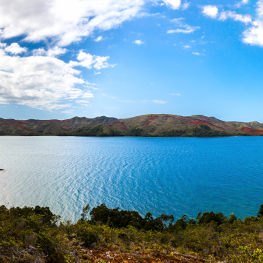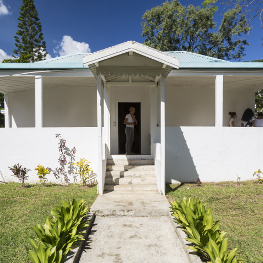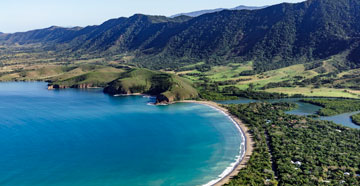Covering a surface area of 700 km², to town of Païta, like neighboring Dumbéa, has experience intense urban development in recent years. Still, it’s a town still steeped in the “bush” spirit, as shown by its traditional ox festival.
For decades, the Tontouta airport in the area of Païta has alone symbolize the town’s modernity. For some fifteen years, urbanity has largely expanded the geographic sphere of the international airport. And the recent opening on city land of the biggest concert hall in the territory, the Arène du Sud, now represents its current dynamism.
Delicious Païta strawberries and the ox festival
In spite of this strong urbanization, Païta has still lost nothing of its bush spirit. The crop-growing (including the famous Païta strawberry) and horticulture are still strongly anchored locally. The same goes for beef farming, celebrated every year in October with the traditional and popular Ox Festival.
Thus the town plays a role of the storehouse of Nouméa, which it has held since the early 20th century.
Also during this same period, between Nouméa and Païta, via Dumbéa, a railroad existed that would ensure that the village would thrive during its entire lifespan from 1914 to 1939 (from 1904 to 1914, the line only went from Nouméa to Dumbéa). Unfortunately, the first (and last) Caledonian passenger railroad would close to do low ridership. Rare vestiges are still visible today.
Mont Mou and Mount Humboldt: hiking for everyone
From a tourist’s point of view, the city has lots of advantages. Beside the presence of four horseback-riding centers on its land, the town encompasses Mount Humboldt and Mount Mou. Both are reputed spots for foot hiking. The two mountains feature staggered plateaus and hills up to the plains of Païta and Saint-Vincent, with the valleys of Tontouta and Tamoa splitting them upstream and downstream from the Pirogue pass.
- Nouméa Tourism Office
- Opening hours: Quai Ferry from Monday to Friday : 8:00-10:30, Saturday : 9:00-15:30. Anse Vata every day : 9:00-12:30 & 13:00-17:00.
- Telephone: +687 28 75 80
- Email: info@office-tourisme.nc

- Dumbéa
- Boulouparis
- La Foa
- Farino
- Moindou
- Bourail
- Koné
- Voh
- Kaala-Gomen
- Koumac
- Poum
- Pouembout
- Poya
- Bélep
- Sarraméa
The history of the town of Païta is closely linked with the historical figure James Paddon. After his career in the English Royal Marines, then as a merchant marine, he settled in New Caledonia starting in 1853. After setting up an important trading post on Nou island, he exchanged it for a vast 4,000 hectare estate in Païta. Making friends with Chief Kuindo, he settled there in 1859 and had 18 Australian families immigrate there, called the “Paddon” immigrants. When he suddenly died from pneumonia in 1861 at the age of 49, he was buried on the land. His tomb has been listed as a historical monument since 2012.
Discover the must-sees in Païta
Voir plusKatiramona Petroglyphs
In New Caledonia, there are about 150 identified sites which have petroglyphs. Among them is that of Katiramona, in Paita city. It is the closest visible s...
Read moreMount Humboldt
If Mount Panié (1627 m) is the highest point of New Caledonia, Mount Humboldt (sometimes nicknamed Pic Humboldt) follows it closely, with the height of 1 6...
Read moreThe villa-museum
On the Road to Gadji, in Païta, at the end of a path dominated by an old turbine, a small hummock with black woods and sandalwood contains one of the most ...
Read moreWhat to do in Païta?
Païta also features an emotional spot in Katiramona. There, a few steps from the road, you can visit a site of petroglyphs partially covered by vegetation. Here, like elsewhere in New Caledonia, it is a complete mystery how old these millennia-old engravings are or even what they mean.

















